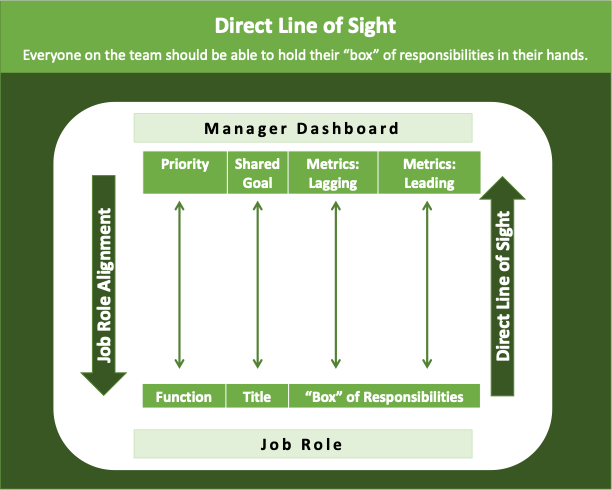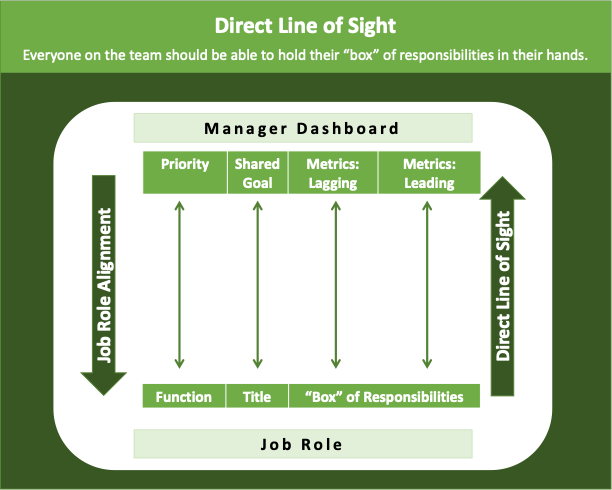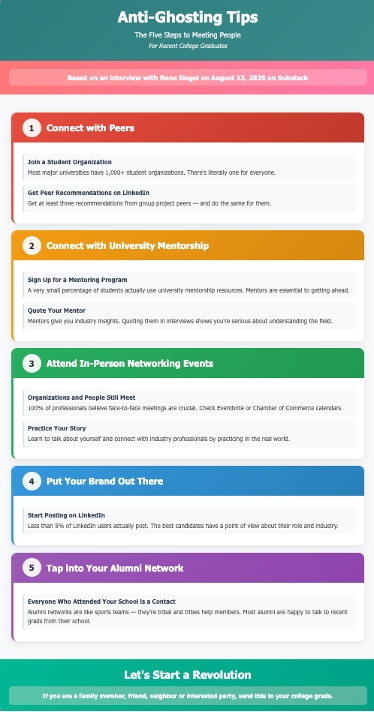Consistency as a manager starts with a Consistent Framework

When I first started managing people I developed a reputation for being a “line of sight” manager — meaning, I tended to ask the last person I saw to do the same thing I had just told the person before them, and maybe another person or two before them.
Sometimes I spun up two or three teams focused on the same problem. It’s literally the definition of management insanity, asking team members to work on something that someone else thinks is their responsibility.
I got better as a manager over time, but as a boomer manager with the corporate ladder standing behind me, it was easy to be inconsistent and mis-align so many people in their job roles. In the consulting business where I worked at the time, the ladder from account executive to senior account exec to group account executive to vice president to partner was laid out and well-known — a 10+-year journey.
In the boomer generation, it was okay to have a job role misaligned every now and then. It’s a whole new game today.
Millennials and gen-z know corporate ladder no longer exists for them because of AI and the era of efficiency it created. The next generation of talent doesn’t have time for misalignment — they know job roles aligned to a manager’s dashboard are the only way to write a chapter in a career story that sets them up to grow and advance to the next stage.
That’s why I’m devoting the next five issues of this newsletter to provide a consistent framework for managers to drive alignment — to motivate and help people write a chapter of their career story.
Here are the five parts:
- The Manager Dashboard— Job Role Alignment Framework
- Why a common vocabulary is the secret ingredient to alignment
- How shared goals set the context for a “box” of responsibilities
- Metrics: There can only be one scorecard of success
- Alignment examples: Writing a chapter of a career story
How Consistent is Your Manager?
The Core Challenge
The key to consistent management: every job role on your team must have direct line of sight to the priorities, goals, and metrics on your dashboard. Everything else is “out of alignment.”
Can someone on your team literally "hold" their responsibilities in their hands? Can they point to their 1-3-5 daily tasks and easily connect them to what you're accountable for delivering? It’s up to you as team manager to set the context for everyone’s “box.”

What Matters: Three Essential Elements
Every manager’s dashboard is informed by these three elements — without them, you haven’t set the context for your team.
- Priorities - Strategic direction-setting tools that determine what matters most and guide resource allocation.
- Shared goals - Alignment mechanisms that unite teams around common objectives.
- Metrics - Measurement tools that track progress and define accountability boundaries.
How Responsibilities Align
- Priorities act as filters: Without clear priorities, people struggle with the overwhelming sense that everything is equally urgent. Priorities separate what is important from wha is urgent.
- Shared goals provide context: They give meaning to individual tasks and help people understand how their work contributes to something larger. When this connection is unclear, work feels fragmented, which means every responsibility in the box seems like an individual job.
- Metrics create boundaries: They clarify not just what someone is responsible for doing, but what results they're expected to achieve. The more impactful the metric, the bigger the opportunity to grow.
Your Homework Assignment
Think about yourself and how you manage your team. What would your team say about the clarity of your priorities, shared goals, and metrics? Are you consistent? Do people have direct line of sight to them?
How Consistent is Your Manager?
Manager Thought of the Week
"Strategy is for amateurs; operations is for generals."
When I heard Cisco's head of engineering say this 20 years ago, it became permanently etched in my head. To all managers: you are a general running a team. You are an operator. Alignment is your friend. The greater alignment to your operation, the more successful you'll be.
In Summary: Principles of Managing in the Age of Uncertainty
- I left Cisco to answer this question with research and evidence: What does the manager of the future look like? What are millennials and gen-z seeking in a manager? Which behaviors, tactics, skills or processes matter? What’s it going to take to attract and keep the best people over the next decade? In short, how to be a great manager.
- Based on this research, the core philosophy of this newsletter is rooted in one idea: successful managers in this moment in time, for this generation of talent, need to be “career dot-connectors.” The next-gen doesn’t expect to spend their entire career on your team — that’s an idea boomers grew up with. A job on your team is like a chapter in a career story to the current generation. If you want the best people on your team, you have to connect the dots between roles on the team and the career opportunities of the people working on the team.
- What is the“Age of Uncertainty”? If the industrial age was about taking predictable steps up the ladder, the age of uncertainty is about finding or discovering the path of a career without any predictable steps, without an obvious ladder — it’s why being a career dot-connector will differentiate you as a manager.
- How to be a Great Manager in the Age of Uncertainty: Be a Career Dot Connector is available on Amazon.
- What kind of manager are you? Take my free self-assessment and learn about yourself.




